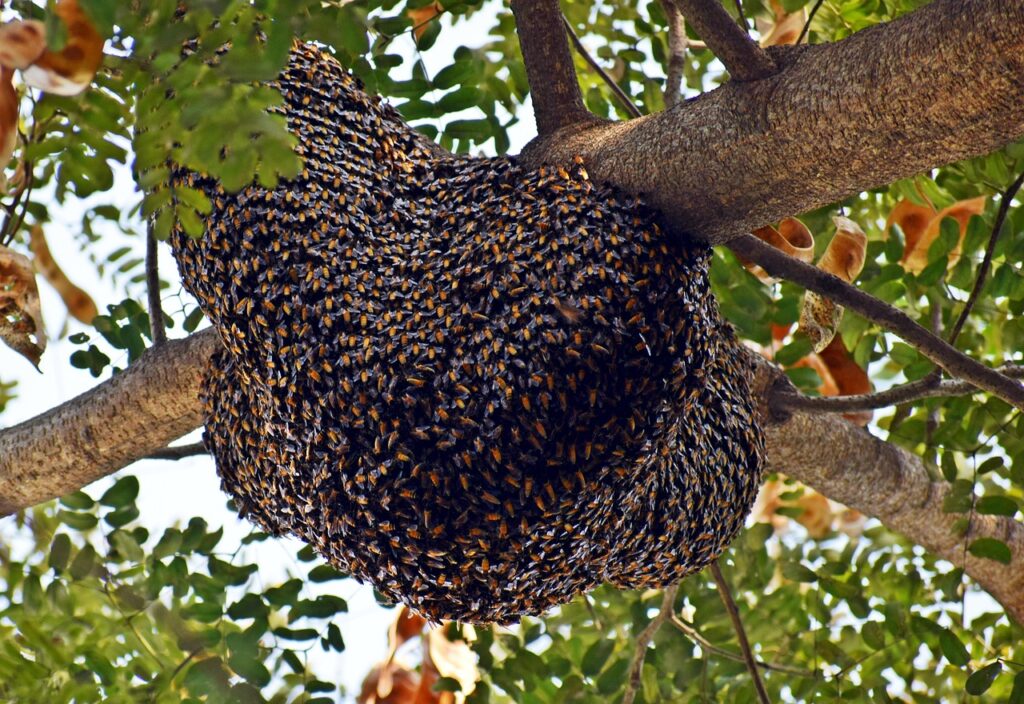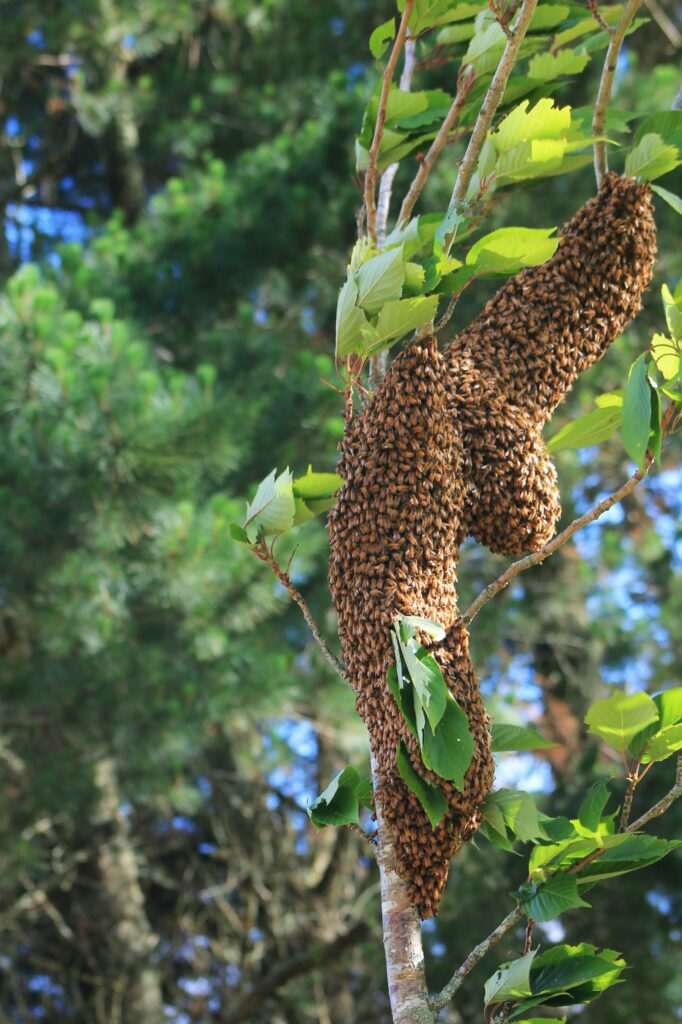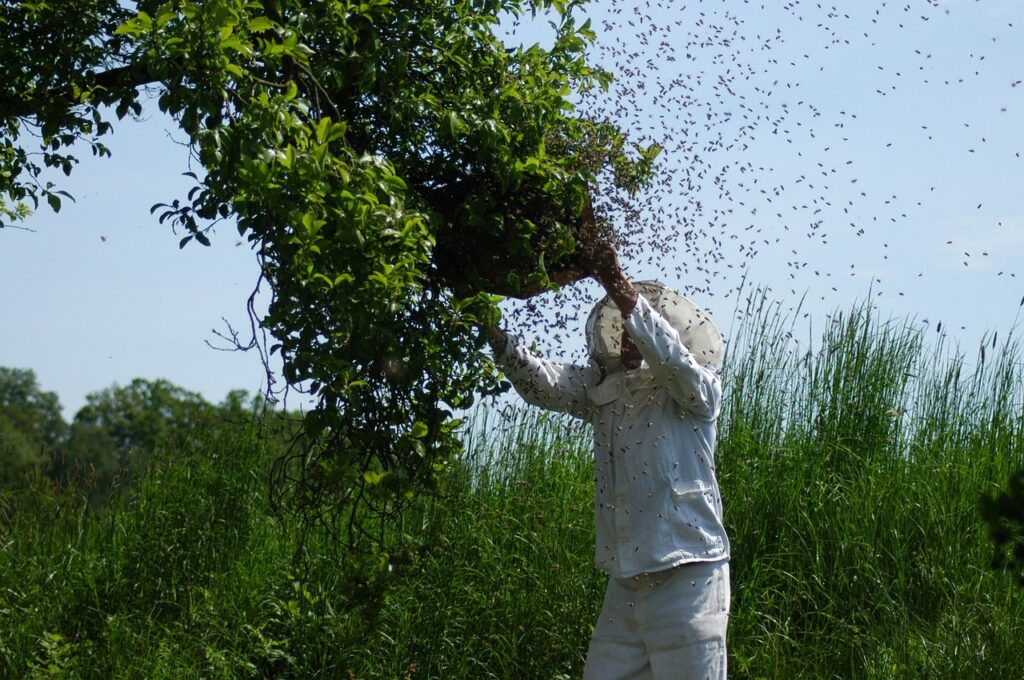Seeing a large bee swarm in the wild can be frightening – but don’t be scared! Swarming honeybees are entirely natural and carry out a process that keeps bee colonies healthy and happy.
We know that a bee swarm is an enormous formation of thousands of bees flying together… but what is the significance of bee swarms? How do they work, and why do they exist? Well, keep reading for more on this fascinating and important natural process.

What Is A Bee Swarm?
A bee swarm and the act of ‘swarming’ is how a bee colony reproduces itself. This usually occurs when the hive becomes overpopulated and bees run out of space. This induces a bee swarm where 50 to 60% of the worker bee population and one queen (usually an old queen, but sometimes a new one) splits from the colony to establish a new hive.
However, bee swarms can also occur when a beehive becomes unsafe or negatively impacts the hive’s health. The entire colony will leave its hive as one body to establish a new one rather than splitting in two. This is often due to the following:
- Parasites
- Disease
- Environmental disturbance
- Erratic weather patterns
- Lack of water and food nearby
- Lack of ventilation
However, it’s important to understand that while this creates a bee swarm, it is technically referred to as ‘absconding’, not bee swarming, which is what we will be referring to in this article.
The Purpose of Bee Swarms
These swarming patterns are an essential part of the colony’s survival. They occur when there are too many bees in the hive: overpopulation leads to crowding, and overconsumption of resources, causing starvation and a rapid decline of the colony’s population. It also allows the colony to continue its biological imperative of reproducing without worrying about dire side effects.
The same goes for hives that are abandoned due to becoming untenable – staying in a compromised hive will directly damage the health of all bees and the status of the colony over time.
How Do Bee Swarms Form?
Bee swarming is a process that requires a lot of preparation in advance before the migration can start. And it all begins with the queen bee.
The role of the queen bee
Since most bee swarms require the original queen bee to be moved to the new hive, worker bees must prepare her to leave. This begins with two things – the workers must restrict how much the queen can eat so she is light enough to fly from the hive, and the queen must lay new eggs in a ‘queen cup,’ which is a small wax cup used to rear new queen bees. One of these eggs will be the new queen bee of the hive when the older queen leaves.
The process of swarm creation
Once the old queen is prepared, and the new queen has been raised, the swarm will be created and the new hive established. This takes place over a series of steps:
- It begins with 50 to 60% of the colony leaving the hive, prompting the queen to follow.
- The queen and most of the swarm will stop at an interim destination somewhere between the old hive and the new, allowing her to rest. The swarm will surround her to keep her safe.
- A few scout bees will continue – it may take them anywhere from an hour to a few days to find the right location. During this period, you are most likely to notice a bee swarm as they wait and rest.
- Once the scout bees have settled on the best place for a new hive, the queen will be taken to their new location to settle, the swarm will break up, and their new life in this second hive will begin!

Where Do Bee Swarms Go?
But the process of bee swarming also poses another interesting question. Why do bee scouts choose the locations that they do? And how do they make those decisions?
Bees begin searching for a new hive between 10 am to 2 pm on the chosen day, often when the weather conditions have changed from cold to warm, which tends to trigger bee swarms.
Scout bees begin searching for their new home – the major factor that helps them decide where they’ll settle is the level of protection the new location provides. Their new hive must be sheltered from the elements and potential disruption, as well as be exposed enough that there is enough sunlight to keep the hive warm. New hives will usually have a small sheltered entrance too.
Typical locations for new hives include:
- Former hives (now empty)
- Hollows inside trees
- Chimneys
- Caves
Once the scout bees have found enough sites with good potential, they will return to the waiting hive. Here they perform a “waggle dance,” a series of vigorous movements that communicate the new site’s location and suitability. During the dance, the scout bees will “vote” on the best location. Once a decision has been made, the swarm can officially relocate.
The Benefits of Bee Swarms?
Bee swarming has benefits and setbacks, depending on how you look at it. Of course, the major benefit of bee swarms is that they keep bees alive and allow colonies to reproduce, which is a net good for the environment. Bee pollination helps to prop up the world’s food systems. As major pollinators, they contribute to producing 87% of food crops worldwide, according to the Food and Agriculture Organization.
So naturally, the practice of bee swarms helps contribute to worldwide food production since it is directly responsible for the survival and longevity of millions of bee colonies worldwide.
On the other hand, bee swarms are seen as a problem for beekeepers. Since it’s difficult to predict where the location of the new hive will be, a bee swarm can result in a 50% population loss for them. This leads to a loss in honey and a significant reduction of the original hive as the bees may struggle to produce after such a drop in population and productivity. This is especially true for commercial beekeepers, who effectively lose income when swarming occurs.
This can lead to beekeepers going to great lengths to stop bees from swarming at all.

The Dangers of Bee Swarms
When you see thousands of bees moving in a group, it’s natural to wonder whether they pose a danger to you. But the truth is that, for the most part, bee swarms are not dangerous.
In fact, swarming bees are less likely to sting you than they might normally be. This is for two reasons:
- Swarming bees feed before leaving the hive, which reduces the likelihood of them stinging
- They are less defensive than they are while in the hive since they aren’t in “home defense” mode
But of course, this doesn’t mean it’s 100% safe. If the bees are bothered or disturbed, they may react by defending the cluster, which could lead to stings from individual or multiple bees.
The species of bee can also influence how dangerous the swarm may be. Common honey bees, or European honey bees, are more likely to be docile and non-defensive than Africanized honey bees or hungry bees with sparing access to food.
Removing A Bee Swarm
If a bee swarm is on your property or inside a building you own, and you want the swarm removed, you should first contact a beekeeper. This should be done as soon as possible before the swarm begins establishing its hive. Once a hive is established and the new colony begins producing honeycomb, they will become much more defensive and thus more difficult to remove.
It’s important to contact a beekeeper rather than an exterminator, as they will know how to contain and relocate the swarm without eradicating any of the bees. Contacting pest control will likely result in the destruction of thousands of bees, which would be disastrous. Bees are good for the earth, so keeping that swarm alive is essential!
How Can You Safely Observe A Bee Swarm?
Though they may seem alarming initially, it’s hard to deny the beauty of a bee swarm. These swarms are one of nature’s most breathtaking performances, and many people, whether they are beekeepers or otherwise, may feel tempted to pause and watch the display.
As mentioned above, bee swarms are not directly dangerous but can sting if threatened. If you want to watch the bee swarm migrate safely, the best thing you can do is watch from a distance or better yet, watch from indoors.
If you are at a distance and the swarm begins to move in your direction, avoid panicking or acting hastily. Don’t make any jerky movements; above all, don’t swat at any bees – even if they land on your skin. Slapping a bee will put it into defensive mode and likely lead to a bee sting.
The Challenges Facing Bee Swarms
The major challenges facing bee swarms right now are the same challenges facing all bee colonies worldwide today, resulting in the widespread decline of bee populations. These are the major threats affecting the health of both wild and domesticated bees and their habitats. These include:
- Spreading urbanization
- Use of pesticides
- Intensive agriculture
- Climate change
All of these things have contributed to both the destruction of habitats where bees are most likely to swarm and establish new hives and the masses of plant life that bees pollinate and use as food sources.
There are also challenges facing swarms specifically. For example, uninformed people are likely to call exterminators to come and take care of a nearby bee swarm, which usually involves exterminating most of the swarm.
The other challenge that bee swarms face is that of beekeepers. For beekeepers, bee swarming is a sure sign that they are about to lose their surplus of honey, something they will go to great lengths to prevent. This usually includes providing more room for the growing bee population, adding more honey supers (trays used to collect honey), and a queen excluder, which keeps the queen bee from entering the honey supers.
The Future of Bee Swarms
Spreading awareness and information about bee swarms is essential – how they work, why they are formed, and their relative safety for the general public. This will help people better understand how to respond to large bee swarms around their homes without calling exterminators or attempting to intercept swarms and newly built hives themselves.
Beekeepers can also play a part in ensuring a better future for migrating bees. They can help colonies to continue their vital reproductive processes by providing the right conditions to allow their bee numbers to expand and reproduce without the need to swarm.
And of course, better environmental practices around bees as essential pollinators will make the future a safer place for swarms. Reduced impact of human behavior on bee habitats means more accessible areas for wild bees to migrate to and establish new hives.
Conclusion
Bee swarms are an astonishing, beautiful, and sometimes frightening phenomenon that is also an entirely natural process. Not only is it natural, but it is a vital part of keeping bee populations healthy and allowing colonies to reproduce repeatedly.
These insects play a crucial part in sustaining worldwide food crops – without bees, it would take billions of dollars to replace the part they play in our global food systems.
Hopefully, learning more about why bee swarms exist and how they work has helped you to understand their significance in the environment and their relative safety for the average person who encounters them in the wild. Whether you are a beekeeper or not, bee swarms should be seen not as a scary sight but as a very welcome one.
- Do Bug Zappers Kill Bees? Completely Explained - April 9, 2024
- Does Brake Cleaner Kill Bees? Full Explanation - March 20, 2024
- Do Bald-Faced Hornets Kill Honey Bees? & How to Protect Them - March 4, 2024
